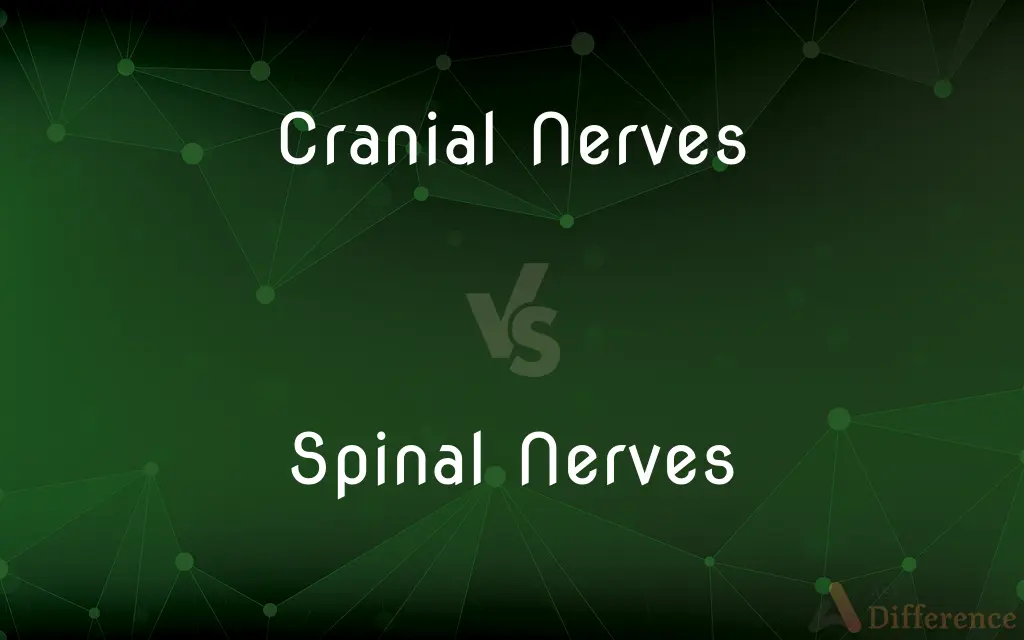Cranial Nerves vs. Spinal Nerves — What's the Difference?
By Tayyaba Rehman — Published on December 26, 2023
Cranial Nerves originate in the brain and serve the head and neck. Spinal Nerves arise from the spinal cord and supply the rest of the body.

Difference Between Cranial Nerves and Spinal Nerves
Table of Contents
ADVERTISEMENT
Key Differences
Cranial Nerves are a set of 12 paired nerves that arise directly from the brain. They primarily serve the regions of the head and neck. These nerves are vital for functions such as vision, hearing, taste, and facial movements. On the other hand, Spinal Nerves arise from the spinal cord, which extends from the base of the brain through the vertebral column. They play crucial roles in transmitting information between the rest of the body and the central nervous system.
Unlike the 12 specific Cranial Nerves, there are 31 pairs of Spinal Nerves. These are grouped according to their location along the spine: cervical, thoracic, lumbar, sacral, and coccygeal. While Cranial Nerves often have specialized functions related to senses or muscles of the head and neck, Spinal Nerves provide both sensory and motor functions to the regions of the body they innervate.
Cranial Nerves include familiar ones like the optic nerve, which is involved in vision, or the olfactory nerve, related to the sense of smell. Spinal Nerves, however, are more generalized in their functions. They branch out to innervate muscles, skin, and organs throughout the body, facilitating both sensation and movement.
While damage or dysfunction in Cranial Nerves can lead to problems like loss of vision or taste, issues with balance, or facial muscle paralysis, issues with Spinal Nerves can result in pain, numbness, or paralysis in the affected area of the body. Both sets of nerves are crucial for the body's sensory and motor functions, but they serve different areas and have distinct roles.
Comparison Chart
Origin
Arise directly from the brain.
Emerge from the spinal cord.
ADVERTISEMENT
Number
12 pairs.
31 pairs.
Primary Regions Served
Head and neck.
Rest of the body.
Examples
Optic nerve (vision), olfactory nerve (smell).
Cervical nerves (neck), lumbar nerves (lower back).
Potential Dysfunction
Loss of vision, facial paralysis, hearing loss.
Pain, numbness, paralysis in the corresponding body area.
Compare with Definitions
Cranial Nerves
Essential conduits for sensory and motor functions in the head and neck.
Any damage to Cranial Nerves can impact senses like vision or taste.
Spinal Nerves
Nerves branching out from the spine to muscles, skin, and organs.
Movement and feeling in our torso involve Spinal Nerves.
Cranial Nerves
The 12 paired nerves serving primarily facial and sensory functions.
One of the Cranial Nerves is responsible for our sense of smell.
Spinal Nerves
Nerves that emerge from the spinal cord.
Spinal Nerves connect the spinal cord to various body regions.
Cranial Nerves
Nerves that originate directly from the brain.
The optic and auditory are examples of Cranial Nerves.
Spinal Nerves
The neural pathways facilitating communication between the body and the central nervous system.
Damage to Spinal Nerves can lead to numbness or pain in specific areas.
Cranial Nerves
Nerves governing senses such as sight, hearing, and smell.
The functioning of our eyes is reliant on specific Cranial Nerves.
Spinal Nerves
31 paired nerves serving sensory and motor functions in the body.
The sensation in our limbs is governed by Spinal Nerves.
Cranial Nerves
Neural pathways connecting the brain to the head and neck regions.
Cranial Nerves play a role in facial expressions and sensations.
Spinal Nerves
Essential conduits for reflex actions and body sensations.
Without properly functioning Spinal Nerves, reflex actions might be impaired.
Common Curiosities
What regions do Spinal Nerves serve?
Spinal Nerves innervate the entire body except the head and neck, which are served by Cranial Nerves.
Can dysfunction in Cranial Nerves affect vision?
Yes, damage to certain Cranial Nerves, like the optic nerve, can impact vision.
How do Spinal Nerves differ from Cranial Nerves?
Spinal Nerves arise from the spinal cord and serve the rest of the body, while Cranial Nerves originate in the brain and serve the head and neck.
What are Cranial Nerves?
Cranial Nerves are 12 paired nerves originating directly from the brain, serving the head and neck.
How many Cranial Nerves are there?
There are 12 pairs of Cranial Nerves.
Can issues with Cranial Nerves affect hearing?
Yes, problems with specific Cranial Nerves, like the auditory nerve, can impact hearing.
What might damage to Spinal Nerves result in?
Damage to Spinal Nerves can cause pain, numbness, or paralysis in the corresponding body area.
Are all Cranial Nerves involved in sensory functions?
No, while many Cranial Nerves have sensory roles, some are primarily motor, and others have mixed functions.
How are Spinal Nerves classified?
Spinal Nerves are grouped based on their location along the spine: cervical, thoracic, lumbar, sacral, and coccygeal.
What happens if a Spinal Nerve is compressed?
Compression of a Spinal Nerve can result in pain, numbness, or weakness in the area the nerve serves.
How do Spinal Nerves connect to the body?
Spinal Nerves branch out from the spinal cord to innervate muscles, skin, and organs throughout the body.
Are Cranial Nerves visible in a brain scan?
Some Cranial Nerves can be visualized on detailed brain scans, depending on the imaging technique.
Share Your Discovery

Previous Comparison
Arts vs. Fine Arts
Next Comparison
Primary Metabolites vs. Secondary MetabolitesAuthor Spotlight
Written by
Tayyaba RehmanTayyaba Rehman is a distinguished writer, currently serving as a primary contributor to askdifference.com. As a researcher in semantics and etymology, Tayyaba's passion for the complexity of languages and their distinctions has found a perfect home on the platform. Tayyaba delves into the intricacies of language, distinguishing between commonly confused words and phrases, thereby providing clarity for readers worldwide.












































